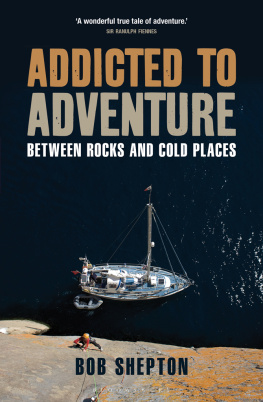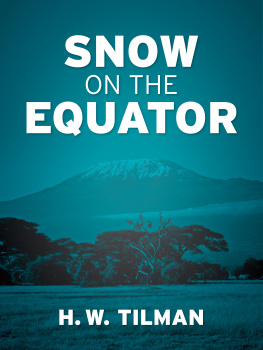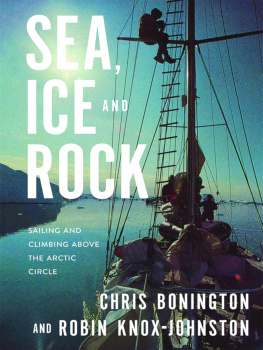
For our youngest daughter Rachel, who has faced real challenges in life and is winning
You are going to enjoy this: a life of adventure surviving the war years on the far side of the world, sailing, climbing, ski mountaineering, in many different parts of the world. It is inspiring that a Reverend should stick his neck out in this way battling Atlantic storms, losing a mast in Antarctica, sailing continually in the Arctic, making the first ascents of mountains, skiing across remote regions, climbing with world class climbers, and sailing through the North West Passage. As a Commando, Bob is clearly made of the right stuff!
BEAR GRYLLS
This is the uniquely interesting and colourful life of an Anglican clergyman turned adventurer. It all started way back in pursuit of his ministry as part of the pastoral outreach and care with young people, especially when he was chaplain at two specialist schools. Bob never retired and his adventures covered the world.
So were they just the ordinary type of adventurous trip here and there? No not really, when you consider they encompass sailing to the Azores as a first ocean passage with school boys not necessarily too taxing, although all navigation was done by sextant in those days and then to Antarctica (losing the mast in the process), round Cape Horn, to the Arctic (including losing a boat to fire when wintering alone in the ice), to Alaska, and crossing the Atlantic fourteen times (so far) and never by the easy route, Canaries to the Caribbean. And finally there is the Northwest Passage in a comparatively small fibreglass boat.
So is it all sailing? By no means! There were those undiscovered and unclimbed cliffs and new rock routes in the 1960s and 1970s at Lulworth and Portland, which he set about developing with members of his church youth group rumour has it that sometimes he had his climbing gear on ready under his clergy robes. Then new routes on the Ormes at Llandudno with boys from St Davids College where he was chaplain, not without some amusing near disasters. And the first ascents of mountains and new rock climbs in Arctic Greenland and Canada from the boat (sometimes literally stepping off the boat to start the climb), including climbing a new extreme route with world-class climbers in Greenland in 2010 when of a certain age, for which expedition the whole group were each awarded a Piolet dOr, perhaps the most prestigious award in the mountaineering world.
And skiing and ski mountaineering? Lots of that too, including ski instructing in Scotland and on the Continent, which included teaching British army groups in Bavaria for several years, downhill and touring, to earn money for the next expedition, sometimes living in extreme conditions to avoid the huge fees for accommodation in Switzerland for instance. Ski mountaineering in the Arctic yielded more first ascents of mountains, and included a repeat of the north-south traverse across Bylot Island in Arctic Canada by that well-known, enigmatic mountaineer and sailor of yesteryear, Bill Tilman.
Parachuting? Yes, but only to take boys from Kingham Hill School when he was chaplain there probably the most scary thing I have done, but then I did start rather late in life for that sort of thing. The formative years of his youth, especially his service with the Royal Marines, coupled with a resolute Christian life fitted him well for leadership and daring. This is a wonderful true tale of adventure with a wide variety of people of all ages, in different parts of the world and over many years. A long, full and varied life, stretching from the days of the British Empire to the present day. A truly interesting book which I definitely recommend.
Bob has climbed for most of his long life. Originally trained as a Cliff Leader in the Royal Marines, he was responsible for discovering and developing the limestone cliffs of Lulworth and Portland and bringing them to the attention of climbers. He made a number of first ascents of climbs on the Great and Little Ormes at Llandudno, with schoolboys, again in the early days of development.
In recent years he has led several private expeditions sailing to and climbing in Greenland and Arctic Canada, and his expeditions there have made over sixty first ascents of mountains and rock faces, not all of them technically hard, but a number also in the Extreme category, and all previously unclimbed. The members of his Greenland Big Wall Climbing Expedition were awarded the Piolet dOr in 2011, including Bob, and he has been called the modern Tilman. All this as well as being, and often in conjunction with being, a Reverend.
Its an interesting and varied life; I commend it to you.
By Red Flower Bagheera meant fire, only no creature in the jungle will call fire by its proper name. Every beast lives in deadly fear of it
THE JUNGLE BOOK , RUDYARD KIPLING
It was during the winter of 2004/5 while alone, ice-bound in Greenland, that I made the simple mistake that destroyed my 33-foot Westerly sailing yacht Dodos Delight and might well have cost me my life.
But sailing up a fjord in Greenland one month and skiing down the same fjord on the winter ice a month later had already been such an enjoyable, novel and intriguing experience.
The autumn had been brutal. A gale drove me out of my first anchorage. I had to haul in 40 metres of chain, hand over hand, as Dodo was blown fast across the fjord towards the rocky shore. My next anchorage, in a cove within a cove, was certainly better protected from southerly gales, but by a curious freak of tidal currents, when the winds were constantly in the north, ice floes would sneak around the corner from the nearby Upernavik Isfjord. A massive, borrowed warp I stretched across the entrance worked to keep fresh floes out, but it also entrapped the ice already inside the cove. When gales broke up the still-forming winter pack ice, huge sheets of it, scraped along Dodos sides. The noise was alarming, but at least at that early stage the ice was still soft and thin and did no real harm.
Eventually, once we were properly iced in, life became so much better. We were secure, protected by the ice sheet (pack ice); growlers and bergy bits or wind-driven floes could no longer reach us. The weather improved and my quality of life improved with it. Now I was able to get out on the ice and walk around, and I could ski over to the nearby settlement at Upernavik for fuel and stores.
Bringing fresh water aboard was much easier too, although it did remain a challenge. Simply getting from the tidal ice to the fast ice (sea ice locked to the land) could be tricky and once, picking my way back to the boat, I stepped on to what I hoped was a solid shard between the fast and the tidal ice only for it to capsize and plunge me into freezing water. It was a struggle to lever myself out, but I managed it, shivering with cold, and was relieved to get back aboard to defrost and change my sodden clothes.
On land, snow shoes were essential footwear when dragging my sled with the water containers to and from the small fresh-water pool I had found, where a stream came down to near the waters edge. Knowing how radically the landscape would change as winter progressed and the heavy snows set in, I had thrust a ski into the ground to mark my precious water supply.
Next page

















